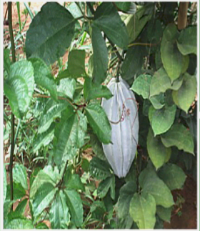Comparative Anti-Anaemia Efficacy of <i>atropha tanjorensis</i> and <i>Telfairia occidentalis</i> Leaf Extracts in Aluminium Chloride (AlCl₃) Induced Anaemia in Albino Rats
Main Article Content
Abstract
Anaemia is a blood illness that threatens public health. The anti-anaemia property of Jatropha tanjorensis and Telfairia occidentalis is known. However, information on their respective measures of anti-anaemia potential is veiled. Comparing the anti-anaemia potential of extracts from the said plants is pivoted in this investigation. J. tanjorensis (JTLE) and T. occidentalis (TOLE) leaves were ground into a fine powder and then macerated. Twenty-one (21) mature male albino rats were divided into seven groups of three (3) rats per group. Anaemia was induced in groups II-VII, after which extracts were administered orally for 21 consecutive days. Group I (normal control) and Group II were not administered extract. The third and fourth groups received 200 mg/kg of T. occidentalis and J. tanjorensis leaf extract, respectively. Groups V and VI received 400 mg/kg of T. occidentalis and J. tanjorensis leaf extracts, respectively. Group VII received extract composite (1:1). Standard techniques were used to evaluate the major anaemia indices. Findings regarding the relative anti-anaemia effectiveness of J. tanjorensis and T. occidentalis leaf extracts revealed that the extracts did not prevent the treated animals' body weight from increasing. Additionally, 200 mg/kg of the composite extract was found to significantly (p< 0.05) raise blood parameters above those reported for their respective components. PCV value recorded with 400 mg/kg bw of TOLE was considerably (p < 0.05) greater than that reported for JTLE. In conclusion, T. occidentalis had a better anti-anaemia potential.
Metrics
Article Details

This work is licensed under a Creative Commons Attribution-NonCommercial 4.0 International License.
References
Camila MC and Parminder SS. Anaemia epidemiology, pathophysiology, and aetiology in low- and middle-income countries. Ann. N.Y. Acad. Sci. 2019; 1450(1): 15–31.
Ashok-Kumar CK, Revathi K, Mohanalakshmi SA. Review on edible herbs as haematinics. Int. J. Pharm. 2012; 2(2): 44-53.
Chaparro CM and Suchdev PS. Anaemia epidemiology, pathophysiology, and etiology in low-and middle-income countries. Ann. N.Y. Acad. Sci. 2019; 1450: 15-3.
Sharda S, Shukla A, Singh CS, Bigoniya P. A review on herbal anti-anaemia plants RGI. IJAST. 2011; 5(6): 456-321.
Roy D, Chakraborty A, Mukherjee P, Ghosh B, Chakraborty M. Recent advances in herbal medicines – an updated review. AJPRD. 2022; 10(1): 45-48.
World Health Organization. Traditional Medicines. [Online]. 2020 [cited 2020 Oct 10]; 2008 Available from: http://www.who.int/mediacentre/factsheets/fs134/en/.
Ansari RA, Rabiu KM, Ayuba V, Omolabake OO. Review on Jatropha tanjorensis (Hospital too far); significance as an anti-anaemia plant. Int Blood Res Rev. 2020; 11(4): 1-7.
MacDonald I, Goddidit I, Joseph E. Anti-anemic activity of Jatropha tanjorensis Ellis and Saroja in rabbit. J. Med. Plants Stud. 2014; 2:64-72.
Komolafe CJ, Ifeoma IA, Felix OA, Justina FO. Phytochemical analyses and antibacterial activities of Jatropha Tanjorensis J. L. Ellis and Saroja leaves extract against clinical pathogens. AJRC. 2024; 15 (4): 79-93. https://doi.org/10.9734/ajacr/2024/v15i5298
Ijeoma SN, Okafor AI, Ndukuba PI, Akomas SC. Hypoglycemic, haematologic and hypolipidemic activity of Jatropha tanjorensis ethanol leaf extract in alloxan-induced diabetic rats. Ann Biol Res. 2014; 5(10): 1-6.
Idu M, Igbafe G, Erhabor J. Anti-anaemic activity of Jatropha tanjorensis in rabbits. J Med Plants Stud. 2014; 2(1): 64-72.
Umoren E, Okon IA, Emmanuel Modo EU, Etim OE, Brown, U. Owu DU, Bassey A. Jatropha tanjorensis (Euphorbiaceae) ameliorates aspirin-induced hepatotoxicity and maintain electrolytes balance in albino Wistar rats. PhyPlu.2023; 3(4): 100450
Auwal Y, Bardea MI, Imam N, Murtala. A Proximate analysis of Telfairia occidentalis (Fluted Pumpkin) and Telfairia pedata (Oyster Nut) leaves consumed in Katsina Metropolis: A comparative study. Recent Adv. Nat Sci. 2023; 1 (2023): 8
Nneoyi-Egbe AF, Onyenweaku E, Akpanukoh A, Ebai P. Haematinic and hepatoprotective properties of Telfairia occidentalis fruit mesocarp on phenylhydrazine-induced anaemia in experimental rats. Hindawi Biochem. Res. Int. 2023; 8838481: 11 https://doi.org/10.1155/2023/8838481
Akpasi SO, Oghenejoboh KM, Shoyiga HO, Kiambi SL, Mahlangu TP. Investigation of the nutrient composition of fluted pumpkin (Telfairia occidentalis) under herbicide treatment. Sustainability. 2023; 15: 3383. https://doi.org/ 10.3390/su15043383
Jones-Bolin S. Guidelines for the care of and use of laboratory animals in biomed res. 2012; 59(1): 4-9.
Koffuor A, Amoateng P, Andey A. Immunomodulatory and erythropietic effects of aqueous extract of fruits of Solanum torvum Stwartz (Solanaceae). Pharmacogn Res. 2011; 3: 130-134.
Tatiana KMK, Joel A, Konan AMK, Sitapha O, Gbe KNAK, Diane K, Larissa AK, Chiaye CAY, Adou KMK, Joseph D. Anti-anemic potential of herbal recipe against phenylhydrazine-Induced anaemia in rats. J. Dis Med. Plants. 2023; 9(2): 40-48. doi: 10.11648/j.jdmp.20230902.12
International Committee for Standardization in Hematology. Recommended methods for measurement of red cells and plasma volume. J. Nucl. Med. 1980; 2:793
Virgil FF and Ayalew T. Normal ranges for packed cell volume and haemoglobin concentration in adults: Relevance to 'apparent polycythemia. Eur J. Haematol. 2000; 65(5): 285-296.
Arika WM, Nyamai DW, Musila MN, Ngugi MP and Njagi ENM. Hematological markers of in vivo toxicity JHTD. 2016; 4:2.
Ghrayeb H, Elias M, Nashashibi J, Youssef A, Manal M, Mahagna L, Refaat M, Schwartz N, Elias A. Appetite and ghrelin levels in iron deficiency Anaemia and the effect of parenteral iron therapy: A longitudinal study. PLoS ONE 2020; 15(6): e0234209.
Rabeh NME, Kady KA, Elmasry HG, Abdelhafez BI. Effect of feeding Moringa oleifera (Moringaceae) leaves extract on rats with induced iron deficiency Anaemia. Nat. Volatiles & Essent. Oils. 2021; 8(5): 13276-13287.
Halfon P, Penaranda G, Ringwald D, Retornaz F, Boissel N, Bodard S, Feryn JM, Bensoussan, Cacoub P. Laboratory test for investigating Anaemia: From an expert system to artificial intelligence. Pract Lab Med. 2024; 39:e00357
Cyril-Olutayo C, Agbedahunsi J, Elufioye O. Antisickling properties of some indigenous and exotic plant species in Nigeria. Planta Med.2012; 78(11): I2- 17.


